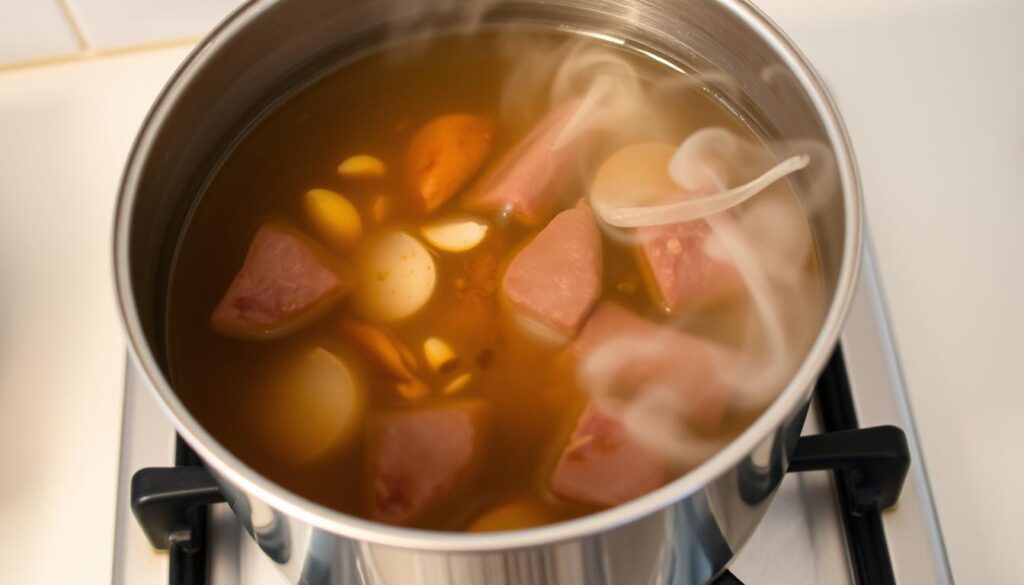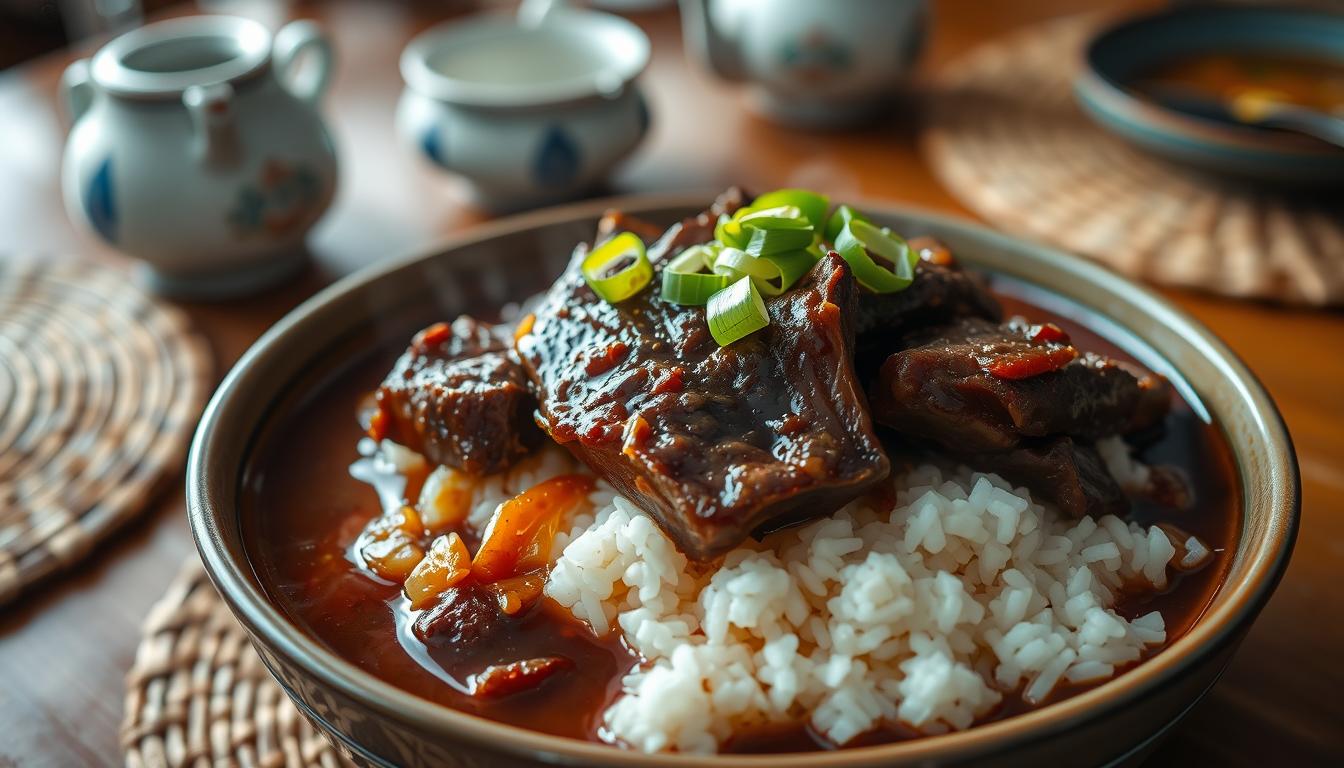When the world feels too much, a steaming bowl of beef pares takes you to Manila’s busy streets. This Filipino beef stew is more than food—it’s a warm hug for your soul. It connects families through its delicious flavors.
Beef pares started in 1970s Quezon City’s street food scene. It’s not just a recipe; it’s a cultural treasure. It combines tender beef, garlic rice, and a comforting broth loved by all in the Philippines.
If you’re looking for a taste of home or want to try something new, this beef pares recipe is for you. It’s a journey into Filipino cooking traditions.
Table of Contents
Understanding Filipino Beef Pares: A Street Food Legend
Traditional beef pares is more than a meal. It’s a journey through Manila’s lively street food scene. This dish turned simple ingredients into a comfort food loved by many.
The story of beef pares started in Metro Manila’s late-night food stalls. Hungry workers found quick, tasty meals here. These small eateries were where this dish was born, spreading across the Philippines.
Origins in Manila’s Food Scene
In the late 1980s, street vendors perfected beef pares. The Original Pares Mami House, started in 1989, was key in making it popular. With five branches in Metro Manila, they made street food a national favorite.
- Emerged from late-night street food culture
- Affordable pricing (typically P40-P280)
- Popular among workers and food enthusiasts
Evolution from Street Food to Home Cooking
Beef pares went from a quick meal to a favorite home dish. Families started making it at home, adding their own touches and tastes.
Cultural Significance in Filipino Cuisine
Beef pares is more than food—it’s a cultural experience. The name “pares” means “pairs,” for the beef and garlic fried rice. It shows Filipino skill in making great meals from simple things.
A dish that connects generations through flavor and memories.
Essential Ingredients for Authentic Beef Pares
Making authentic beef pares starts with picking the right ingredients. It’s all about choosing the perfect cut of meat. This turns the dish into a tender, delicious treat.
Your beef pares sauce needs a special mix of ingredients. This mix adds depth and richness to the dish. The classic recipe includes:
- 4 lbs beef shank (or alternative braising cuts)
- 5 thumbs of fresh ginger
- 10 cloves of garlic
- 1 tablespoon beef powder
- 5 pieces of star anise
- ½ cup soy sauce
- 2 tablespoons oyster sauce
- ¾ cup brown sugar
- 3 tablespoons cornstarch
When picking your beef, look for cuts like brisket, short ribs, shanks, chuck, or round. The key is choosing meats that benefit from slow cooking. These cuts might be tough at first but become tender and full of flavor after slow cooking.
The secret to beef pares is in its flavors. Sweet, savory, and umami all come together. Each ingredient is important for the dish’s unique taste. This taste has made beef pares a favorite street food since 1979.
Selecting the Perfect Cut of Beef
Choosing the right cut of beef is key for a delicious beef pares recipe. The success of your dish depends on picking meat that becomes tender and flavorful during cooking.
Your beef pares journey starts with understanding which cuts work best for this classic Filipino comfort food. Not all beef cuts are created equal when learning how to cook beef pares.
Best Cuts for Tender Results
For the most tender beef pares, consider these top meat selections:
- Beef Brisket: The gold standard with excellent marbling
- Chuck Roast: Rich in flavor and perfect for slow cooking
- Short Ribs: Provides exceptional richness and depth
Understanding Meat Marbling
Marbling refers to the white fat streaks running through the meat. More marbling means more flavor and tenderness. When selecting beef for your pares, look for cuts with moderate fat distribution.
Budget-Friendly Alternatives
If premium cuts stretch your budget, don’t worry. You can still create a delicious beef pares using more affordable options:
- Beef Shoulder
- Bottom Round
- Flank Steak
Pro tip: Slow cooking transforms tougher cuts into melt-in-your-mouth meat!
Remember, the key to an amazing beef pares is patience and the right cooking technique, regardless of the cut you choose.
The Secret Behind Clear and Flavorful Broth

Making a clear and tasty beef pares sauce begins with a great broth. To cook beef pares well, focus on meat prep and cooking methods.
The trick to a clear broth is blanching. Here’s what you need to do:
- Blanch the beef for 8-10 minutes in boiling water
- Drain and rinse the meat well
- Change the water to get rid of impurities
- Skim off any foam when it first starts simmering
Aromatics are key for depth in your beef pares sauce. Fresh ginger, star anise, and whole garlic cloves make a big difference. They add rich flavors and keep the broth clear.
Simmering at a gentle heat is important. Fast boiling can make the broth cloudy. You want a clear, flavorful broth that highlights the beef’s taste.
Pro tip: Always use cold water when starting your broth and bring it to a gentle simmer for the clearest results.
By using these methods, you’ll make a broth that’s as good as a restaurant’s. It will impress everyone with its clarity and flavor.
Mastering the Braising Technique
Braising is key to making a real beef pares recipe. It turns tough beef into tender, delicious meat. Learning to slow cook is essential.
The secret to great beef pares is gentle heat. You want a slow simmer that tenderizes the meat without losing its softness.
Temperature Control Tips
- Keep the heat between 180-200°F for optimal tenderness
- Use a heavy-bottomed pot to distribute heat evenly
- Avoid rapid boiling, which can toughen the meat
Timing and Tenderness Tests
Cooking time is usually 1.5 to 2 hours. Check the beef’s tenderness with these methods:
- Fork test: Meat should easily pull apart
- Gentle pressure test: Beef should feel soft when pressed
- Cut test: Slice should separate without resistance
Sauce Reduction Methods
A rich, glossy sauce is vital for beef pares. To get this:
- Remove meat and reduce liquid on high heat
- Skim excess fat for a clearer sauce
- Adjust seasoning during reduction
Pro tip: Patience is key when braising beef pares. Low and slow always wins!
Creating the Perfect Garlic Fried Rice Pairing
When making beef pares with garlic rice, the key is choosing the right rice and mastering cooking. The best recipe for beef pares includes a garlic fried rice that matches the savory meat perfectly.
Here are some tips for authentic beef pares with garlic rice:
- Use day-old cold rice for the best texture
- Choose long-grain white rice
- Dry rice thoroughly before frying
- Use 15-20 garlic cloves for intense flavor
The secret to great garlic fried rice is in the rice prep. Cold, slightly dried rice prevents clumping and ensures each grain separates perfectly during frying. Heat 3 tablespoons of neutral cooking oil and sauté minced garlic for 1-2 minutes until golden brown.
Your garlic rice should be crispy, fragrant, and full of flavor. Add chopped scallions for extra depth. Season with kosher salt, light soy sauce, and white pepper. This simple side dish makes your beef pares a top-notch meal.
Pro tip: Let your rice rest in the refrigerator overnight for the best texture and flavor absorption.
Traditional Beef Pares Seasoning Guide
Making the perfect beef pares sauce is all about finding the right mix of flavors. It turns simple ingredients into a dish that’s truly special. The secret is in the seasoning.
The magic of beef pares sauce is its mix of sweet and savory tastes. It’s a journey of flavors that starts with knowing the key ingredients.
Essential Spices and Aromatics
- Fresh garlic (3-4 cloves, minced)
- Ginger (2 tablespoons, finely chopped)
- Soy sauce (1/4 cup)
- Brown sugar (2 tablespoons)
- Star anise (1 whole)
- Ground black pepper (1 teaspoon)
Balancing Sweet and Savory Flavors
To make authentic beef pares sauce, you need to be precise. The secret is layering flavors. Start with caramelized garlic and ginger, then add soy sauce and brown sugar for sweetness. Star anise brings a warm touch that makes the dish stand out.
“In Filipino cooking, balance is everything. Your beef pares sauce should tell a story of sweet, savory, and umami in every bite.”
Seasoning is key. A little more sugar can make your sauce unforgettable. Traditional beef pares is about finding harmony in flavors, showing off Filipino street food’s rich heritage.
Step-by-Step Cooking Process

Learning to cook beef pares takes patience and focus. It starts with careful prep and precise cooking. These steps turn simple ingredients into a tasty Filipino dish.
First, get your ingredients ready for the beef pares recipe. You’ll need 2 pounds of beef brisket cut into 1½-inch cubes. This size ensures even cooking and tender meat.
- Blanch the beef in boiling water for 8-10 minutes to remove impurities
- Drain and rinse the meat thoroughly
- Heat oil in a large pot and brown the beef cubes
- Add chopped onions, garlic, and ginger to develop deep flavors
- Pour in 6 cups of water and your seasoning mixture
Bring the mixture to a boil, then reduce heat to a gentle simmer. Cover and let the beef cook slowly for 2 to 2.5 hours. This slow cooking makes the meat tender and the flavors rich.
To thicken the sauce, mix 2 tablespoons of cornstarch with 4 tablespoons of water. Stir this into the broth during the last 15 minutes of cooking. This step gives the sauce its glossy look, just like authentic beef pares.
Pro tip: Taste and adjust seasonings throughout the cooking process to ensure a perfect balance of sweet and savory flavors.
Your beef pares is ready when the meat is fork-tender and the sauce is rich and glossy. Serve it hot with garlic fried rice for a full Filipino meal.
Professional Tips for Restaurant-Quality Results
Making the best beef pares recipe needs focus and patience. Professional chefs say it’s all about practice and detail. By learning key techniques, you can make your home cooking as good as a restaurant’s.
- Control your cooking temperature carefully between 185-195°F for optimal tenderness
- Allow meat to rest 15-20 minutes after cooking to retain moisture
- Use a recommended 1 kg beef cut for the most consistent results
- Ensure internal meat temperature reaches 195°F for maximum flavor
Avoiding Common Cooking Mistakes
The biggest mistakes in beef pares cooking can ruin your dish. Rushing the cooking process makes the meat tough. Slow braising breaks down connective tissues, making the meat tender.
Achieving Perfect Texture and Consistency
Professional chefs suggest keeping the simmering temperature steady. They also recommend using 8-10 cups of beef stock for braising. Blanching meat for 8-10 minutes before main cooking removes impurities and enhances flavor.
“The secret to restaurant-quality beef pares lies in patience and precise temperature control.” – Filipino Culinary Expert
By using these professional tips, you can make your beef pares a memorable meal, just like in a restaurant.
Serving and Presentation Techniques
When you serve traditional beef pares with garlic rice, aim to bring the essence of Filipino street food to your table. Choose a wide, shallow bowl to highlight the rich beef broth’s colors. Place the beef pieces in the center, making them the main attraction.
Arrange your beef pares with care. Make a small mound of garlic fried rice on one side. This adds texture and aroma. Ladle the broth around the meat, balancing the flavors.
Top it off with chopped green onions for color and a hint of sharpness. Adding pickled vegetables or a calamansi wedge can brighten the dish. These touches enhance both taste and look, reflecting Filipino cuisine’s focus on flavor and culture.
Serving family-style adds an authentic touch. It encourages everyone to share and talk, mirroring Filipino food culture’s communal spirit. This turns a meal into a memorable experience that brings people together through delicious food.
FAQ
What exactly is beef pares?
Beef pares is a favorite Filipino dish. It’s tender braised beef with garlic fried rice and a tasty broth. It started as a street food in Manila and is now a key part of Filipino cuisine. It’s known for its rich, sweet-savory taste.
What cut of beef works best for beef pares?
Brisket and chuck are the best cuts for beef pares. They have lots of marbling and get very tender when slow-cooked. This makes the beef melt in your mouth, just like in traditional beef pares.
How long does it take to prepare beef pares?
Making authentic beef pares takes about 2-3 hours. You need to marinate the beef for 30 minutes, braise it for 1.5-2 hours, and make garlic fried rice for 15-20 minutes. The slow cooking is key to getting the deep flavors.
Can I make beef pares with a different type of meat?
You can try using chicken or pork instead of beef. But, you might need to adjust the cooking time and method. This ensures the meat is tender and full of flavor.
Is beef pares spicy?
Traditional beef pares is not spicy. It has a sweet and savory taste from soy sauce, sugar, and spices. If you like it spicy, you can add chili sauce or fresh chili peppers.
What should I serve with beef pares?
Serve beef pares with garlic fried rice and its own broth. You can also add pickled vegetables or a simple salad. Some people like it with a soft-boiled egg for extra protein.
How do I store leftover beef pares?
Keep beef pares in an airtight container in the fridge for 3-4 days. The flavors get better overnight, making it great for meal prep. When reheating, use low heat and add broth to keep the meat moist.
Can beef pares be made in a slow cooker?
Yes, beef pares is perfect for a slow cooker. The slow heat breaks down the meat and enhances the flavors. Just marinate the beef, then cook on low for 6-8 hours or high for 4-5 hours until it’s tender.
Source Links
- Beef Pares – https://www.kawalingpinoy.com/beef-pares/
- Filipino Beef Pares (Braised Beef) – Kusina Secrets – https://kusinasecrets.com/filipino-beef-pares-braised-beef/
- Here’s Where to Eat Beef Pares Mami Around Metro Manila – https://thebeat.asia/manila/delish/happenings/ready-your-tummies-heres-where-to-eat-beef-pares-mami-around-metro-manila
- Pares (food) – https://en.wikipedia.org/wiki/Pares_(food)
- Retiro Beef Pares with Chicharon Bulaklak – https://panlasangpinoy.com/retiro-beef-pares-with-chicharon-bulaklak/
- Beef Pares Recipe: A Flavorful Filipino Delight – https://www.miraclerestaurantgroup.com/beef/beef-pares-recipe/
- Beef Pares Recipe – https://getrecipe.org/beef-pares-recipe/
- Beef Wonton Mami – https://www.kawalingpinoy.com/beef-wonton-mami/
- Beef Pares Recipe – Sweet, Savory, and Perfectly Braised – Kinglet WW – https://www.kingletww.com/beef-pares-recipe/
- Beef Pares Recipe | Panlasang Pinoy Meaty Recipes – https://www.panlasangpinoymeatrecipes.com/beef-pares-recipe.htm
- Easy Filipino Beef Pares Recipe For Comfort Food – https://www.tastemeats.com/filipino-beef-pares/
- Filipino cuisine – https://en.wikipedia.org/wiki/Filipino_cuisine
- Filipino Beef Pares Recipe – The Recipe Website – https://therecipe.website/filipino-beef-pares/
- Garlic Fried Rice (Sinangag) in 20 Minutes (VIDEO) – CJ Eats Recipes – https://cjeatsrecipes.com/garlic-fried-rice/
- Beef Pares: A Comforting and Flavorful Filipino Classic | quickreciper.com – https://www.quickreciper.com/beef-pares-a-comforting-and-flavorful-filipino-classic
- How to Cook beef Pares Recipe – https://www.recipemeats.com/beef-pares-recipe/
- Batchoy Recipe – https://panlasangpinoy.com/batchoy/
- 12 Restaurants in Manila You’ll Want to Fly For | Will Fly for Food – https://www.willflyforfood.net/best-restaurants-in-manila/









